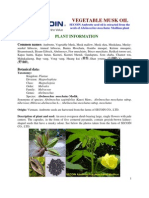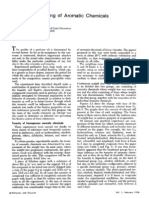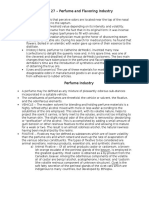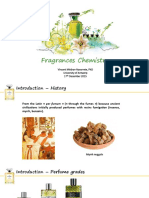1 PDF
1 PDF
Uploaded by
Christopher BrownCopyright:
Available Formats
1 PDF
1 PDF
Uploaded by
Christopher BrownOriginal Title
Copyright
Available Formats
Share this document
Did you find this document useful?
Is this content inappropriate?
Copyright:
Available Formats
1 PDF
1 PDF
Uploaded by
Christopher BrownCopyright:
Available Formats
Since ancient times, substances that produce fragrant smoke on burning have been deployed
not only to capture the whole atmosphere with a fine fragrance but also for their curing
properties and the purification of environment. This philosophy paved the path for the
evolution of Agarbatties (Incense Sticks). Originally the chip of Agarwood was known as
Agarbatti.
AGARBATTI (INCENSE) INDUSTRY IN INDIA
Natural herbal Agarbatti (Incense) has been known since ancient times for its beneficial
influence on body and mind and in more modern times herbal incense is used in
aromatherapy. According to the Ayurveda, India's ancient system of natural healing, quality
Herbal incense enhances health, induces inspired thought, and creates a peaceful state of
consciousness.
The finest spices, herbs, floral extracts, exotic oils and other natural ingredients are carefully
selected for their positive influenceskillfully blended with a base of gums and resins. The
fragrances and properties of each variety of our Herbal Incenses are unique, inspiring and
uplifting.
Agarbatti & Aromatherapy:
Inhalation and fumigation, two of the main modes of administration of this ancient healing
modality, are easily and effectively achieved through the use of natural scents. Because such
fragrances can be used environmentally or for targeted applications, it has become the
aromatherapy of choice for countless millions throughout the planet.
Daily use of natural fragrances, prevents disease, promotes longevity, harmonizes the psycho-
physical constitution, and increases mental clarity.
Agarbatti is miniature form of Yagna, which involved with development of time for sake of
convenience. Indians has been doing Yagna as daily part of life to send their fragrant message
by upward emerging fume to God who is believed to stay above. In present time Agarbatti has
not only played role of fragranting message to God but mankind which stays in its vicinity due
to its tremendous spreading power at most economic cost.
Chronological development of Agarbatti Industry development in India is as follows: -
Development of Agarbatti Industries in India in 19
th
Century & potential in 20
th
Century
1. Pre nineteenth century Yagna were most common method of getting fragrance through
burning in India. Infact name perfume is composed of two parts Per Sacred in Greek,
Fume smoke, so perfume world came from sacred smoke.
2. In the beginning of 19
th
Century Tanjour in Tamilnadu emerged as one centre where
Agarbatti making was started based on need of local temples & kings.
3. Art of making Agarbatti by 1920 shifted to Mysore as forest based raw material like
Sandalwood, Jiget, Bamboo, Charcoal, Halmandi & other Aromatic plants were
available from local area. This art was supported by kings of Mysore so it took semi
Industrial shape by 1930 whereby Mysore Agarbatti attained its importance through
out India due to tourist traffic.
4. Karnataka was rich in forest which had enough of two species namely a) Jiget (Michilus
macrantha) also known as Maida Lakadi, used for binder. b) Halmandi (Ailanthus
malbarica) used for making Masala Agarbatti. This two species along with Sandal
brought Mysore first & late Bangalore in Map of Agarbatti Industry. This gave rise to
development of rolling skill for Agarbatti.
5. Continuous development of 50 years from 1930 to 1980 brought Karnataka with
Bangalore & Mysore as production base all India suppliers for quality Agarbatti &
generated employment of 25 million man-days.
6. Constant depletion of forest with increasing consumption made dependence of
Karnataka on raw material to other states in Northeast region, which slowly gave rise to
birth of other centre for production in late 90s. Sudden development of IT industry in
Bangalore made rapid rise in property price around city making Agarbatti industry
unviable. This gave rise to development of raw Agarbatti in many nearby village as well
new production centres.
7. Based on consumption pattern, many new Agarbatti manufacturing centre emerged in
various part of country. They are Nagpur, Raipur, Pune, Ahmedabad, Delhi (Islampura),
Varanasi, Gaya and Cuttack. It was observed that more concentration towards
Northeast was due to very economic labor, availability of raw material & market, which
was served up to this time by Karnataka.
8. Constant shift of Fragrance for Agarbatti from Natural to Synthetic perfume enable
starting of Agarbatti Industry in any part of India.
9. This showed decline of Karnataka Agarbatti Industry with all major successful brands
in last five years from other places like Hirwa Chafa from Pune, Zed black from
Indore.
10. With rising consumption of Agarbatti in Northeast along with production of raw
Agarbatti in place like Gaya future place of production will be Bihar & Assam
surpassing Karnataka, which is already known for IT industry.
11. If proper planning is done for raw material & production of quality products, Northeast
can become area of Agarbatti production serving not only domestic market but entire
segment of Fareast Buddhist country who are largest importer of Agarbatti from India.
In last few years, Incense is attracting lot of our attention for research. After reading books on
Incense, we started more detailed detail work on 100% natural like 1) Frankincense, 2)
Sandalwood, 3) Rose, 4) Patchouli first and propose to extend on 5) Myrrh, 6) Lotus, 7) Jasmine
Sambac 8) Vetivert 9) vegetable musk like Ambrette seed or Angelica, 10) Himalayan oils like
Costus, Irish, Spikenard etc.11) Forest oils/absolute like Fir, Pine needle/leaves with Cedar
wood as base entirely in natural way.
1) Frankincense 2) Sandalwood 3) Patchouli 4) Rose with trial on Geranium Sandal
combination first and are in process to standardize 5) Myrrh 6) Lotus 7) Jasmine Sambac 8)
Benzoin 9) Vetivert 10) Musk with help of natural plant material like Ambrette Seed and
Angelica root, which are only two best resources for natural musk 11) Himalayan Oils like
Costus, Cedarwood, Iris, Spikenard etc 12) Forest note with help of oils/ Absolutes of Fir, Pine
Needle/ Leaves, Orrise Clary sage, Mosses like Oak 13)
Galbanum.
First work started with Frankincense as after reading book we felt that it is liked by all and
brings all type of prosperity with removal of all problems which is becoming very common now
a days if same is burned in proper direction with full faith. We selected both Boswellia Sarrata
and Cartrie from India and Oman respectively and found that Boswellia Sarrata is very nice for
many reason. We observed that it is very difficult to make incense from raw resin as same
contains lot of sand and twigs which comes as part of raw resin since same is collected as
forest product after Monsoon. So we removed all external impurity from it by melting and
filtering it and mixed with natural molasses ethyl alcohol so that it remains in liquid state.
Then we dipped raw incense (made out of bamboo, coal dust, powder of tree bark tree bark
which has adhesive property) in it and allowed same to dry. Alcohol gets evaporated leaving
resin absorbed on stick making same ready for use.
In the same way, we made Sandalwood incense with 60% hydro distilled +40% CO2 extracted
Sandalwood oil so that we get complete odor of natural Sandalwood. We selected +40 years old
Sandalwood for same purpose as less matured trees cannot emit nice fragrance (as proved
during last so many years of observation). Less matured Sandalwood contains more terpine like
alpha and beta Santalenes (hydro carbons without oxygen atom) as compare to Santalols like
beta and photo Santalols (hydrocarbons with oxygen), which are responsible for characteristic
odor and therapeutic property. This wood we can able to procure from Govt. department, which
is collected only after they mature, or falls.
In case of Rose we used extract from Rose Petals (Rose Edward) obtained after CO2 extraction.
Same is very thick and contains lot of wax (also known as stereoptins in case of flowers like
Rose, Jasmine etc.). Interestingly dipping on raw incense it gave little yellow color to coated
when this extract mixed with alcohol incense and same on burning emitted very powerful
fragrance of natural Rose. We never anticipated such powerful fragrance from such extract,
which was very weak in odor when smelled as such. The reason was Rose Petals, which were
extracted, were looking like dead flower but it was containing live force in them by way of this
stereoptins (wax) which is not visible by ordinary smelling however when they were burned
(trying to send them to god) they started speaking in form of powerful odor. Thus we realized
why Japanese calls incense ceremony as listening of fragrance.
In case of Patchouli we have seen very good power of it in many incense, which are popular in
India from last 50 years. All-most >90% successful brands in market are containing Patchouli
oil. During various experiment while processing Patchouli leaf we observed that spent leaf after
hydro distillation contains many ingredient, which are very diffusive when the same leaf,
burns. So we extracted with solvent spent Patchouli leaf and combined it with hydro distilled
oil making available total extract.
We have experience here in India that Incense is one of best medium to distribute fragrance of
plant material in simplest way without harming environment. Few of observation we come
across while evaluating incense is as follows.
Experiments carried on Incense by us & our opinion :-
1) Incense have enough power to make a person alert when he/she is in sub-conscious state.
We experienced it with Frankincense and Sandal Incense. It is our experience after burning
many hundreds of stick that Frankincense is very very powerful in morning and purifies our
mind and surrounding atmosphere also. In India all Yagna, begins with chanting of Mantra
and offering frankincense in early morning. We saw that even single stick with proper
concentration is enough to make whole house full of nice odor of frankincense/Sandalwood.
2) We observed that place of keeping incense is also very important. As recommended by old
literature that if we light it in Northeast direction of place where we are leaving/working then it
is most auspicious. It is really giving very powerful odor, which directly penetrates our mind as
observed by us in all places. It is important that good ventilation should be there at place
where incense is burning. If we are in direction of air then it is ok other wise we should visit
nearby area and feel power of it.
3) Incense made from natural products like Frankincense, Sandal, Rose Pattel extracts,
Patchouli etc. have hardly any odor of there own when we smell incense as such. It emits nice
aroma only when we burn them. We can feel their power when same smokes spreads with air
and creates nice atmosphere in surrounding. As observed in common marketplace most
incense have very strong odor, which hardly appears when we burn same. We thought over
same and carefully tried to analyze it with help of holistic thinking which gave us proper
answer which was very difficult to get through modern analytical methods.
During our past experience of >5 year in incense business common expectation of any
customer in India as seen very commonly are Nice odor on first smelling as such
a) After burning smell should spread with in 10 min. to maximum surrounding area.
b) After burning totally smell should remain for prolonged time in surrounding atmosphere
making any one happy whosoever comes there even after 20 min.
On analyzing many incense available in market we came to common conclusion that many
products available in market can achieve first objective with almost 90-95% success but
second objective is achieved maximum to 50-60% level but third object is achieved hardly 30-
35% in case of synthetic product. Masala natural incense can achieve third objective up to 90-
95% level but normally fails in first. If second objective is achieved up to 90-95% level than
product becomes most successful. Also famous incenses are using a natural resin known as
HALMANDI which is very expensive and due to excess use it has become very much in short
supply and may become extinct in future. Even today it is very difficult to get pure
HALMANDI like Agar wood. This observation made our direction very clear that we should not
use Halmandi but we can use many other natural product for achieving similar finished
product which will be liked by common person more if product will be having less smoke and
availability problem. Here we feel smoke is symbol of show which is very much visible but every
one knows that same is harmful and we should keep our self away from same.
Halmaddi :- The botanical name is Ailanthus Malabarica. An Ornamental, deciduous large tree
growing naturally in the Western Ghats of India, Kokan southwards. When a moderately deep
incision is made on the bark of standing trees, a fragrant resin called Halmaddi (Kannada
name) oozes out, which is used in the manufacturer of Agarbathies. After collection, it is
distilled & then used in Dhoop & Agarbathies (Incense). Many popular hand-rolled Indian
Incense sticks are made from the perfumed resins of Halmaddi tree.
Common Ingredients of Agarbatti
Jigat :- Jigat powder (an adhesive-like substance made from powdered bark of the Maclilus
makarantha tree). The Agarbatti industry mainly depends on forest based raw materials like
'Jigat', which helps to preserve the fragrance of the incense stick.
Agarwood : The name AGARBATTI has been derived from Agarwood which has been used for
burning. Agarwood is from trees of the genus aqualaria that grow mainly from northeast India
down into southeast Asia. The wood is heavy, dark and hard. When the tree is infected by a
group of fungi it creates a resinous oil (apparently to defend against this fungi) which has a
deep, dark, rich, beautiful, woody aroma. The wood is used as an incense for both pleasure
and spiritual enhancement. The essential oil distilled from this wood (known as Oud in Arabic)
is used for the same reasons as well as a perfume and medicine. The wood is mentioned in the
Bible as Aloes.
Frankincense : It is a resin derived from plant of Boswellia Serrata. Its principal use now is in
the manufacture of incense. The word 'incense,' meaning originally the aroma given off with the
smoke of any odoriferous substance when burnt, has been gradually restricted almost
exclusively to Frankincense.
Sandalwood : Botanical name is Santalum Album. It is considered as "Liquid Gold" of India.
Sandalwood is one of the oldest incense materials, and has been in use for at least 4,000
years. It is one of the most calming incenses and therefore, is one of the preferred ones for
meditation. It calms the mind, enhances mental clarity, and aids in the opening of greater
awareness.
Patchouli :- Botanical name is Pogostemon cablin. This earthy and musk-like pure essential oil
is perhaps best known as an incense. It is an effective anti-depressant when inhaled.
Rose :- Botanical name is Rose Edward. It refreshes the mind, uplifts the memory.
Myrrh :- It is a natural Oleo-gum resin derived from trunk of the small trees of COMMIPHORA
species. Myrrh Gum is known to contain many volatile oils which make the herb ideally suited
for promoting free breathing during congestive colds, and for clearing out mucous-clogging
passages in the body. It was used as incense in religious rituals throughout the ancient world.
It promotes spiritual awareness and is uplifting.
Vegetable Musk :- a) Ambrette Seed : Botanical name is Ambelmoschus moschatus. Removal
of fatty acids from Ambrette seed oil gives a clear yellow to amber liquid with the strong, musky
odor of ambrettolide. On of the natural source of Musk.
b) Angelica Seed : Botanical name is Angelica archangelica. The oil
has musk like odor. Both these oils are used in very low % in Agarbatti.
Iris Concrete :- Botanical name is Iris Pallida. A number of species grow in Himalayas at an
altitude of 1600- 3500m.
Mosses like Oakmoss :- Botanical name is Evernia prunastri Oakmoss is a lichen mainly
found on oak trees. The resinoid is obtained by extraction of the moss. An earthy, mossy, spicy,
woody odor. Odor resembles more close to nature. Mainly acts as fixative.
You might also like
- Agarwood - Science Behind The Fragrance-Springer Singapore (2016)Document175 pagesAgarwood - Science Behind The Fragrance-Springer Singapore (2016)OsamaAliMoussa100% (2)
- Introduction To Perfumery - PerfumersWorld2Document1 pageIntroduction To Perfumery - PerfumersWorld2Biotech FormularyNo ratings yet
- AgarbattiDocument2 pagesAgarbattiblack horse100% (1)
- Infytq With SolutionsDocument37 pagesInfytq With SolutionsÃbhilâśh Rêddÿ100% (1)
- Herbal Soaps & Detergents HandbookDocument17 pagesHerbal Soaps & Detergents HandbookBala Ratnakar Koneru50% (2)
- Aquilaria Crassna (Agarwood) Study of Pharmacological ActivityDocument6 pagesAquilaria Crassna (Agarwood) Study of Pharmacological ActivityArthur LowNo ratings yet
- Agarwood Biblio v1.02Document36 pagesAgarwood Biblio v1.02mosnaz13100% (1)
- Offer - Vegetable Musk Oils (Ambrette Seed Oils)Document3 pagesOffer - Vegetable Musk Oils (Ambrette Seed Oils)Dinh xuan BaNo ratings yet
- Perfume ApplicatorDocument35 pagesPerfume Applicatorkaushik638No ratings yet
- The Search For New Amber IngredientsDocument10 pagesThe Search For New Amber IngredientsOctavian Coifan100% (1)
- Agarwood InductionDocument13 pagesAgarwood Inductiona b100% (1)
- Suggested Method For Evaluation of Agarwood Oil QualityDocument2 pagesSuggested Method For Evaluation of Agarwood Oil QualityDinh xuan BaNo ratings yet
- PatchouliDocument38 pagesPatchouliBashir AnastasNo ratings yet
- Perfume Formula Worksheet Calculator V2 (YT Shareable)Document22 pagesPerfume Formula Worksheet Calculator V2 (YT Shareable)Oscar Conde ReyNo ratings yet
- Identification of Agarwood-Producing Trees (Summary)Document13 pagesIdentification of Agarwood-Producing Trees (Summary)Dinh xuan BaNo ratings yet
- Heart of The Matter: Agarwood Use and Trade and Cites Implementation ForDocument60 pagesHeart of The Matter: Agarwood Use and Trade and Cites Implementation ForAri Syuhada PutraNo ratings yet
- Terpenoid and PerfumeDocument5 pagesTerpenoid and PerfumeJillian Mae DacerNo ratings yet
- Chemical Composition of Agarwood Oil Cvh1Document4 pagesChemical Composition of Agarwood Oil Cvh1Dinh xuan BaNo ratings yet
- Translating Smells Into Colors - A Proposal For Improve The Perception of Perfume Packaging DesignDocument15 pagesTranslating Smells Into Colors - A Proposal For Improve The Perception of Perfume Packaging DesignzahraNo ratings yet
- Proceeding of Gaharu Workshop DEVELOPMENT OF GAHARU PRODUCTION TECHNOLOGY PDFDocument144 pagesProceeding of Gaharu Workshop DEVELOPMENT OF GAHARU PRODUCTION TECHNOLOGY PDFasiapowerdriveNo ratings yet
- Project Report On Agarbatti Synthetic Perfumery Compounds & Agarbatti Compounds Like Champa, Mogra, Sandal Wood & LobanDocument5 pagesProject Report On Agarbatti Synthetic Perfumery Compounds & Agarbatti Compounds Like Champa, Mogra, Sandal Wood & LobanEIRI Board of Consultants and PublishersNo ratings yet
- Firmenich - Collaborative Supply Chain StrategyDocument16 pagesFirmenich - Collaborative Supply Chain Strategyedwinwong81No ratings yet
- The Imitation and Creation of A Mango FlavorDocument6 pagesThe Imitation and Creation of A Mango FlavorJANANI MNo ratings yet
- Niir Modern Technology Perfumes Flavours Essential Oils 2nd EditionDocument15 pagesNiir Modern Technology Perfumes Flavours Essential Oils 2nd EditionRabi ShankarNo ratings yet
- Characterization of Essential Oils by Gas Chromatography Characterization of Essential Oils by Gas ChromatographyDocument4 pagesCharacterization of Essential Oils by Gas Chromatography Characterization of Essential Oils by Gas ChromatographyKevin GuzmanNo ratings yet
- Kynam - Highest-Quality Agarwood PiecesDocument5 pagesKynam - Highest-Quality Agarwood PiecesDinh xuan Ba100% (1)
- VetiverDocument8 pagesVetiverpriyamvadaprabhuNo ratings yet
- Development and Evaluation of Cream Contain Green Tea Extract, Aloe Gel and Vitamin E: As Skin TonerDocument7 pagesDevelopment and Evaluation of Cream Contain Green Tea Extract, Aloe Gel and Vitamin E: As Skin TonerBaru Chandrasekhar RaoNo ratings yet
- PerfumeDocument21 pagesPerfumeoscar allen briosoNo ratings yet
- 1976 FixationDocument9 pages1976 FixationMark EvansNo ratings yet
- Incense Sticks - Agarbatti - Manufacturer & Suplier in USADocument10 pagesIncense Sticks - Agarbatti - Manufacturer & Suplier in USAbalajiincense agarbattiNo ratings yet
- ST Johns Senior Secondary SchoolDocument15 pagesST Johns Senior Secondary SchoolANMOLNo ratings yet
- Indonesian Essential Oils Ministry of Trade IndonesiaDocument52 pagesIndonesian Essential Oils Ministry of Trade IndonesiaBadtz100% (1)
- Clove Bud Oil Fragrance ManographDocument3 pagesClove Bud Oil Fragrance ManographBadtzNo ratings yet
- The Holy Fragrance Ingredients ICEDocument5 pagesThe Holy Fragrance Ingredients ICETom ReményiNo ratings yet
- No Inspected Steps Standard Result Quality Testing SpecificationsDocument1 pageNo Inspected Steps Standard Result Quality Testing SpecificationsNidhiNo ratings yet
- Perfumerflavorist201704 DLDocument68 pagesPerfumerflavorist201704 DLhabbalcNo ratings yet
- Perfume Ch-IDocument15 pagesPerfume Ch-Imkarjun mkarjunNo ratings yet
- Research Paper: Extraction of Ambrette Seed Oil and Isolation of Ambrettolide With Its Characterization by H NMRDocument6 pagesResearch Paper: Extraction of Ambrette Seed Oil and Isolation of Ambrettolide With Its Characterization by H NMRMimbel WimbelNo ratings yet
- Niir Modern Technology Perfumes Flavours Essential Oils 2nd Edition PDFDocument8 pagesNiir Modern Technology Perfumes Flavours Essential Oils 2nd Edition PDFDamayanti MohantyNo ratings yet
- Frter1998 PDFDocument71 pagesFrter1998 PDFcapdesuroNo ratings yet
- Perfume ChemistryDocument2 pagesPerfume ChemistrypjeanNo ratings yet
- 535942695 كتاب عطور 2Document75 pages535942695 كتاب عطور 2Youssef BourasNo ratings yet
- Non Alcholic Perfume From Kashmiri Roses: Nawab Shabir Nayab Dutt Khalid Muzzafar Zubair Bhat Ravish RahejaDocument15 pagesNon Alcholic Perfume From Kashmiri Roses: Nawab Shabir Nayab Dutt Khalid Muzzafar Zubair Bhat Ravish RahejaNeed IsolationNo ratings yet
- Fragrances: Chiral Chemistry in FlavoursDocument6 pagesFragrances: Chiral Chemistry in Flavoursmohamed tharwatNo ratings yet
- Article WJPR 1438667348Document40 pagesArticle WJPR 1438667348Ida NeniNo ratings yet
- Chapter 27 - Perfume and Flavoring IndustryDocument3 pagesChapter 27 - Perfume and Flavoring IndustryAllyaizsaOmarNo ratings yet
- Aroma ChemicalsDocument2 pagesAroma ChemicalsGonang ElHabNo ratings yet
- Aromatherapy by KevilleDocument82 pagesAromatherapy by KevilleGraziele DaineseNo ratings yet
- Uecipest: Book FormulasDocument78 pagesUecipest: Book FormulasErik NguyenNo ratings yet
- Getting FragranceDocument29 pagesGetting FragranceShiv ParNo ratings yet
- Distribution of Aquilaria Species by 15 CountriesDocument2 pagesDistribution of Aquilaria Species by 15 CountriesDinh xuan BaNo ratings yet
- IFRA-RIFM QRA Information Booklet V7.1 (July 9, 2015)Document37 pagesIFRA-RIFM QRA Information Booklet V7.1 (July 9, 2015)Carlos-Ivan TlatoaniNo ratings yet
- Aromatic Candle Making Project PDFDocument14 pagesAromatic Candle Making Project PDFScribdTranslationsNo ratings yet
- VIETNAM. PROCESSING OF AROMA CHEMICALS AND FRAGRANCE MATERIALS. TECHNICAL REPORT - AROMA CHEMICALS AND PERFUME BLENDING (20598.en) PDFDocument83 pagesVIETNAM. PROCESSING OF AROMA CHEMICALS AND FRAGRANCE MATERIALS. TECHNICAL REPORT - AROMA CHEMICALS AND PERFUME BLENDING (20598.en) PDFOsamaAliMoussa100% (1)
- Fragrant Wood Gaharu PDFDocument82 pagesFragrant Wood Gaharu PDFPatricia Njoto100% (2)
- Essential Oils and Fragrances From NaturDocument12 pagesEssential Oils and Fragrances From NaturTom ReményiNo ratings yet
- Patchouli Herb: Commercial Growing Practices and Economic ImportanceFrom EverandPatchouli Herb: Commercial Growing Practices and Economic ImportanceNo ratings yet
- Making Good Scents - Winter 97: The newsletter of handcrafted soaps, cosmetics, and perfumesFrom EverandMaking Good Scents - Winter 97: The newsletter of handcrafted soaps, cosmetics, and perfumesNo ratings yet
- What Are Essential Oils and Aromatherapy?: Natural Ways to Heal the BodyFrom EverandWhat Are Essential Oils and Aromatherapy?: Natural Ways to Heal the BodyNo ratings yet
- Perfume Attars and Their HistoryDocument6 pagesPerfume Attars and Their Historykiez3b79ju100% (1)
- 160930115120Document47 pages160930115120Vinh HoangNo ratings yet
- A Game of Chess & The Fire Shermon (Eliot)Document40 pagesA Game of Chess & The Fire Shermon (Eliot)Sourav KumarNo ratings yet
- Gmail - Importance of Masala Agarbatti - Dhoopbatti CourseDocument4 pagesGmail - Importance of Masala Agarbatti - Dhoopbatti Courserajashekhar asNo ratings yet
- Bubbly Break BrochureDocument20 pagesBubbly Break BrochureHarish KommeraNo ratings yet
- Wizz Europe Cafe - Boutique June-July - 22Document28 pagesWizz Europe Cafe - Boutique June-July - 22Grei KoteNo ratings yet
- STD Qty: Cleopatra Hair BalsamDocument16 pagesSTD Qty: Cleopatra Hair BalsamYungky WandinarNo ratings yet
- Billie Eilish on Her New Fragrance, Embracing Her Femininity, And Why Rihanna is the Hottest Person in the World _ VogueDocument14 pagesBillie Eilish on Her New Fragrance, Embracing Her Femininity, And Why Rihanna is the Hottest Person in the World _ Vogueradgenderfluid069No ratings yet
- Oregano Perfume FinalDocument15 pagesOregano Perfume FinalMarc Neil Cintron100% (1)
- Introduction To BusinessDocument16 pagesIntroduction To Businessarishaafrina02No ratings yet
- Al Rehab PricesDocument2 pagesAl Rehab PricesZahra GajNo ratings yet
- Create Your Own Custom Perfume - FragranceDocument2 pagesCreate Your Own Custom Perfume - FragrancejimNo ratings yet
- Rasasi Catalog Zahras PerfumesDocument82 pagesRasasi Catalog Zahras PerfumesZahra GajNo ratings yet
- Fragancia Fabricante Genero Tipo ML: PrecioDocument22 pagesFragancia Fabricante Genero Tipo ML: PrecioAFERNo ratings yet
- KIZMARK Beauty Fashion - February 2011Document60 pagesKIZMARK Beauty Fashion - February 2011Xiaoxiao LinNo ratings yet
- Oxynex ST LIQUID - Inf TécnicaDocument12 pagesOxynex ST LIQUID - Inf TécnicaAnonymous vqv5q1B100% (1)
- The European Business Review - March April 2024Document102 pagesThe European Business Review - March April 2024rishiraj goswamiNo ratings yet
- Marketing Plan Body Mist: Open Univeristy Special Training Department Principles of Marketing - @@Document41 pagesMarketing Plan Body Mist: Open Univeristy Special Training Department Principles of Marketing - @@thanh nguyenNo ratings yet
- Syed Junaid Alam Catalog Zahras PerfumesDocument46 pagesSyed Junaid Alam Catalog Zahras PerfumesZahra GajNo ratings yet
- 5 Topics Sip C.F.ZDocument81 pages5 Topics Sip C.F.ZJamicah Nicole SolisNo ratings yet
- NIIR List of BooksDocument12 pagesNIIR List of Booksbinoyraj2010No ratings yet
- Personal Care ProductsDocument39 pagesPersonal Care ProductsRachel Taburda100% (1)
- INUKA Product CatalogDocument48 pagesINUKA Product Catalogangelinenomhle7No ratings yet
- Oarr 10000310 1 PDFDocument520 pagesOarr 10000310 1 PDFyoussefNo ratings yet
- Group 4 BSE4A. FRAGRANCE ESSENCEDocument48 pagesGroup 4 BSE4A. FRAGRANCE ESSENCEVeronica LopezNo ratings yet
- Perfume Production in The Ancient WorldDocument7 pagesPerfume Production in The Ancient WorldjoneganaNo ratings yet
- Thesis Statement For Essential OilsDocument4 pagesThesis Statement For Essential Oilsjennymancinibuffalo100% (2)
- Contractubex - US5885581Document4 pagesContractubex - US5885581hana.hovorkovaNo ratings yet
- Research Report For ReferenceDocument107 pagesResearch Report For ReferenceKaustubh ShindeNo ratings yet

























































































